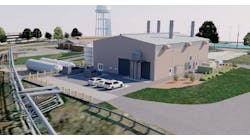The California Public Utilities Commission should require Pacific Gas & Electric (PG&E) to issue a clean energy solicitation this summer to reduce the effects of wildfire-related power shutoffs, according to Tesla and other stakeholders who are participating in a state microgrid proceeding.
The call for the solicitation is in response to a proposed PUC decision on short-term actions that would speed up microgrid development to help reduce power outages when utilities de-energize transmission lines to reduce wildfire risks.
Last summer, California’s three major investor-owned utilities periodically cut off customer power to reduce the chance utility equipment would start wildfires. About 2 million PG&E customers lost their power at least once during the public safety power shutoffs.
The commission in December divided a microgrid proceeding (R.19-09-009) into two tracks and directed utilities to file microgrid plans that could be put in place by September 1, ahead of the upcoming wildfire season.
In the PUC’s proposed decision, set to be voted on at a June 11 meeting, PG&E is given permission to spend about $320 million this year on three programs, including a “temporary generation” program that calls for having up to 300 MW of mobile generation that can be used to create temporary microgrids.
Among other things, the proposed decision allows PG&E to use diesel generators for backup power.
Clean energy solicitation in preparation for 2021
In comments on the proposal, stakeholders urged the PUC to tweak the proposed decision, with some arguing PG&E should issue a request for proposals to help the utility move away from backup diesel generators towards clean energy alternatives.
“The commission could set the expectation that PG&E’s [request for offers] should be truly all source, prioritize clean energy solutions, and encompass centralized facilities as well as allow for consideration of more distributed approaches, including opportunities to leverage existing distributed energy resources, or combinations of the two,” Tesla said.
PG&E could work with stakeholders to develop a solicitation proposal that could be vetted at a workshop held by PUC staff, according to Tesla. Moving now would give bidders enough time so new resources could be in place ahead of the 2021 fire season, the company said.
Parties like Bloom Energy, a fuel cell company, urged the PUC to only allow PG&E to use diesel generators in limited circumstances and should instead order the utility to use clean alternatives.
Utility sees diesel as bridge
PG&E said it plans to develop a proposal for a “Clean Generation Framework” describing the standards and objectives governing the procurement and use of temporary or permanent local generation after 2020 that would be used to mitigate planned power outages.
“PG&E sees the potential use of mobile diesel and natural gas generators as a necessary bridge until non-fossil-fueled alternatives are available,” the utility said. “Nothing in the record of this proceeding supports a determination that alternatives exist today that can provide reliable, long-duration mobile generation on the scale needed to mitigate the impacts of [public safety power shutoffs] events.”
The planned Clean Generation Framework will offer a roadmap for replacing diesel generators over time, according to the utility.
Barring the utility from using backup diesel generators will spur “relatively unregulated, inefficient, unsafe, and inequitable use” of smaller gasoline- and diesel-fueled generators by individual customers, PG&E said.
The California Energy Storage Alliance generally supported PG&E’s plans for a clean generation framework but said it “strongly” supports calls by Tesla and GRID Alternatives for an RFP.
Learn more about microgrid regulatory proceedings at the Microgrid Knowledge Virtual Conference, which will feature a special session, “Will COVID-19 Impact Microgrid Policy Progress?” Monday, June 1, 3 pm EDT.







